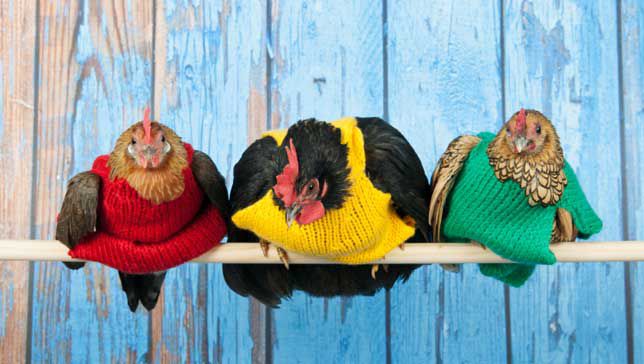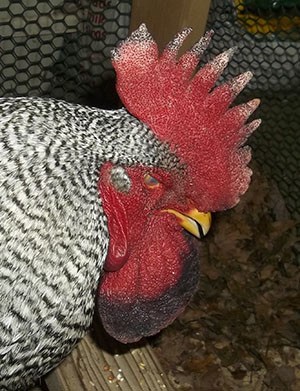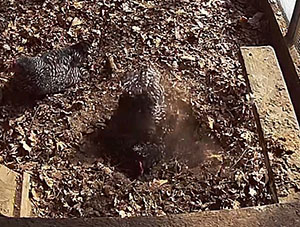
The first snow has fallen and nights here in New Hampshire are in the single digits. How do we help our chickens cope with the harshness of winter? (Hint: we don’t put little sweaters on them) We do, however, take a few steps to help them cope.
Wind Break

The single most valuable thing you can do to help your chickens survive the winter is to stop the wind. They can fluff up their feathers to improve their insulation but their combs, wattles, and feet remain exposed. Windchill is what will get them.
Preventing drafts goes a long way to helping chickens keep themselves warm. I added some foam tape to the coop’s window to make it seal tighter. The goal is to let the air in the coop be fairly still while they sleep.
The tricky part is balancing draft-free and well-ventilated. I have a vent up high, into the protected area of the run, and the open coop-to-run door so air can circulate slowly.
Dry Runs

My first winter keeping chickens, I did nothing special to their run. As such, snow blew in pretty quickly, rendering the entire space inhospitable to bare chicken feet. Even on mild days, they did not want to leave the coop. Since then, I always staple up a layer of plastic around the run. This keeps out the snow so they could have a dry dirt floor. Dry dirt doesn’t freeze solid. It stays fluffy. The plastic also acted as a windbreak so that the door between their coop and run could remain open for better ventilation without increasing draftiness. (And, I did not have to go out each morning to open the coop door to let them into the run.)
Moisture Management

Moisture in the coop’s air can be a disaster for exposed combs and wattles. The moisture collects on those exposed surfaces and freezes causing frostbite. One of my prior roosters (Winston) got a bad case of frostbite on his wattles one winter. They became swollen with fluid buildup. The damaged area eventually turned black and fell off. As you can see from the photo, the tips of his comb got frostbit too. The tips died, turned white, then black, then fell off. Winston survived, but the damaged parts don’t re-grow.
After Winston’s suffering, I made some changes to the coop. I added a vent up high to let out whatever warmer-moister air might arise. I left the coop-to-run door open to encourage more convection.
Two Moisture Culprits
Early on, I made the mistake of leaving the chickens’ water bucket in the coop. Evaporation from their bucket added to the moisture in the coop’s air. The other culprit was their poop. Chickens poop a lot while they sleep. Their warm poop gives off moisture to the air. You can’t stop chickens from pooping, but you can provide an absorbent litter to mitigate the problem.
Deep Litter
Part of moisture management is to go with a deep litter on the coop floor. Some use pine shavings, others use straw. I use shredded leaves from autumn raking. In addition to being free, shredded leaves absorb moisture well. Eight to ten inches of dry leaf shreds readily wick up moisture from their poops. The depth of litter allows the poops to migrate down, away from the surface. The hens do some this when they scratch around in the litter. I help by raking periodically and adding a couple of five-gallon buckets of fresh shreds now and then too, to freshen things up.
While I have read of people saying their deep litter acts like a compost pile, generating heat for the coop, in several years of doing it this way, I have never noticed any increased temperature. By spring, the combination of poop and leaf shreds DOES yield several wheelbarrows of rich compost, so I know there is composting going on in there. It just doesn’t generate any appreciable heat that I’ve been able to see. (Got a thermometer in the coop)
Distant Drinker

Rather than keeping their water bucket in the coop, I place it at the far end of the run. Another reason for doing so is that I am currently using a heated water bowl. It’s actually a heated dog dish, but the chickens haven’t questioned me on that yet. A heated bowl would generate even more moisture, so it definitely should not be in the coop where they sleep.
Before the heated bowl, it was an every-morning chore to take out a new (unfrozen) bucket of water to swap for the frozen-solid bucket. The heated bowl has been wonderful for NOT having to go outside the first thing in the morning.
Fatty Foods
Much of a chicken’s calorie expenditure in the winter goes toward maintaining body heat. Increase their carbs and fatty treats to give them the fuel boost they need. Hiding the snacks amid their litter gives them something to do.
Boredom Busters
Our chickens will go out into the yard until the snow covers everything. They’ll tolerate walking on a little bit of snow or ice but they clearly don’t like it. Being dry is great for keeping warm but chickens who are accustomed to ranging around the yard can get on each others’ nerves when confined to the coop and run. Chickens who get bored will start to peck aggressively at each other for something to do. The prudent chicken-keeper will take some steps to distract and entertain his cooped-up flock.
Leaf It To Me! — Something I’ve done for years is to provide a thick layer of leaves for the run floor. Whole leaves are fairly sturdy so they stand up to regular scratching. What the leaf-litter does is encourage their natural foraging instincts. They will dig and scratch among those leaves for hours. Those are all hours that they are not fighting with each other. To encourage the behavior, I will occasionally go in and sprinkle scratch grains among the leaves. That way, they actually find something delicious. This encourages them to do it more.

Who’s That?— One thing I just installed in the run is a mirror. Chickens are interested in their reflections. Whether they think the reflection is another (stranger) chicken or they recognize themselves, is unknowable. Interacting with their reflection IS distracting, however. The more assertive chickens seem to be the most distracted by their reflections. While they’re trying to figure out who that strange (but good looking) other chicken is, they are not fighting with each other.

Toys! — Yes. Chickens play with toys. I made a couple of chicken toys last year. They are plastic spice bottles with a pumpkin-seed sized hole in their sides. I fill the bottle with half-and-half sunflower seeds (which are like catnip to my flock) and feed pellets. The chickens will roll the toy around on the run floor to get their coveted sunflower seeds to fall out of the hole. They’ll work at it for hours until it is empty. It usually seems to be the more high-strung or aggressive hens that play with the toys the most. This gives all the others a spell of peace and quiet.

Golden Dirt! — Chickens love loose dry dirt for taking dust baths. Normally, dry loose dirt would be rare in the winter. Having the run wrapped in plastic assures that the dirt floor stays dry and therefore loose. I’ve seen four or five of them all wallowing in their own little dirt craters at the same time. This, while the ground is frozen or covered in snow. A chicken that is busy digging a dirt wallow or dust bathing is NOT bothering her flock mates. Actually, dust bathing is a sign that the chicken feels safe and secure. Give your birds a place to dust bathe to encourage happy thoughts!
Conclusion
Keeping your chickens healthy and happy through the harsh winter months is not that difficult. Keep them dry and draft-free and they’ll heat themselves. Give them toys and they’re good for hours. They’ll come through winter just fine.

Mic have you tried giving your chickens a cabbage tetherball? My neighbor hangs a coat hanger with a cabbage in the chicken yard and they love it. Asking your local grocer can sometimes get you unsellable cabbages. Egg trade anyone? Growing a lunch tray of seeds into grassy sprouts is also a molt curing, boredom buster for the girls. Takes a couple of days misting them and keeping in a sunny window. Feed in chunks as they will wipe out the whole tray in a few hours.
Thanks for the shredded leaves idea. Goodness here in NH we have plenty of leaves. How do you shred yours? I’ve used a lawn mower to shred them for composting.
Happy to say I’ve cleaned off my driveway, refilled the sand buckets so ready for next snowstorm.
Hi Michael,
Thanks for commenting. Yes, I tried the cabbage tetherball idea but my birds were freaked out by it. I think they thought it was attacking them. They all hid in the coop until it stopped swinging. I know they love cabbage because they got into my garden and pecked some serious damage. Good idea on the unsellables from a grocer. Will have to ask around. Might try something less threatening, like a cabbage peck-block.
I’ve thought of doing the sprouts. Might try that again — especially now that they’re not going out of the run anymore. We got 18″ of snow from that last storm. For the past few years, I’ve been giving them “silage” that I made out of lawn clippings. They really like it and it gives them some ‘greens’ when nothing is green.
Yes, no shortage of leaves here in NH. I’ve been shredding mine with a leaf blower/vac. I found that the vac chews them up pretty well as they go through the fan. I dump the catcher-bag in a hopper with a lid to keep them dry until needed. I, too, put some of them in the compost pile. They seem to break down pretty quickly once shredded.
Take care, and keep that snow shovel handy!
— Mic